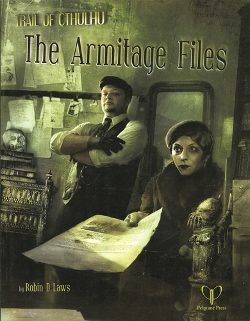Review of The Armitage Files By Pelgrane Press
-== What is it? ==-
The Armitage Files (TAF) is a campaign framework for use with Trail Of Cthulhu. It was written by Robin D. Laws and published by Pelgrane Press. TAF was released in 2010.
The key component of TAF is a set of 10 handouts. The premise for the campaign is that documents are being sent back through time by Professor Armitage as warnings to the PC. The PC have to make sense out of these chaotic documents to stop the impending Cthuhlu threats that they foretell. TAF includes details on many of the people, organizations, places, and objects referenced in the handouts. It also includes a section on improvising.
The book has a color cover and a three color interior. The interior colors are black, white, and an olive drab color. TAF is 8.5†x 11†and is 152 pages in length. I am reviewing a print copy that I bought. I ran a campaign using TAF that lasted for nine sessions.
-== What I Like ==-
Each of the 10 handouts are roughly 3 to 4 pages in length. Some handouts include taped on items, photographs, or small drawings. The documents go from coherent log entries to frenetic chaos induced rants. Even though TAF is essentially in black and white you can download high-resolution color versions of the handouts in PDF format from the Pelgrane Press site. These color versions are brilliant! They are so much fun to analyze that my players poured over each one using their iPads. They zoomed into each stain, rip, and rant with a fine eye. These handouts are masterful. They were created by Sarah Wroot.
The key to TAF is that it be used in an improvisational fashion. The documents are intended to act as hooks that get the PC moving in a direction. The GM is then to lead the players through various layers and twists leadings to a final confrontation. TAF gives the GM advice on how this is to accomplished during each session. This product design is something that I personally have not seen in any other product and it had a dramatic effect on me. I am a QA engineer who loves lists and a fair amount of session prep. I do understand that no adventure survives contact with the players but I also value prep and the impact that it can have on making sessions memorable, coherent, and fun. Running several sessions without prep made me quite nervous. After the first 2 or 3 sessions I started trying to do some prep for various angles when I saw where the players were heading. This did help but it was difficult at times. In one case the players actually caught something in the text that completely derailed most of my session prep. I rolled with it but I’m sure the players could detect my unease.
During these improvisational sessions I took away something from the book that I had heard Paul Tevis spout off about in his podcasts. Paul used a term from improvisational theater called “negating”. The idea is that you never say “no” to your players. Instead you go with their suggestions and add a “but” to further the scene. For example, “The bar is open so you can take a look but it is seedy and crawling with shadowy faces…” This worked well for me during the sessions.
-== What I Don’t Like ==-
As I mentioned above the product really assumes a nearly complete improvisational GM style. What happened with me was that I started off with no prep but I quickly realized that I was having trouble improvising unique plots with detailed clues ahead of my players. As I game with very detailed orientated players (engineers, mathematicians, etc) having detailed clues that are consistent is vital. It was just too difficult for me to do on the fly. To help I started creating small threads that I could pull into adventures. This worked fine at first but quickly got more and more cumbersome.
My players are very detailed orientated but they are also very thorough. Not only did they want to research one thread on a given document they wanted to investigate ALL of the threads on EVERY document. After 9 sessions they had just moved to the THIRD document.
Even though the 10 documents have some threads that connect them TAF does not include any details to help the GM have a strong concrete ending. Instead they let the players and GM improvise this through the course of the campaign. Again this was hard for me to handle at my table.
-== Summary ==-
I was in a seminar with Kenneth Hite at DunDraCon several years ago. During that seminar I asked him if TAF was worth buying. His response was classic Hite…it went something like this, “If Beethoven composes a symphony you buy it; same here.” That is some high praise. 🙂 As a prep heavy GM with detail orientated players TAF was a great experiment but overall it was not for me and my group. For a prep lite GM I can see where this product would be absolute gold. I’m going to give the product 8 out of 10 paws. If you are a prep heavy GM I give it 6 paws but if you are an improvisational prep lite GM I give this 10 paws. 😉
I give it 8 out of 10 paws.
TAF can be purchased at Noble Knight Games at this URL. Amazon has copies for $26.27 at this URL. The book is at DriveThruRPG at this URL for $16.95.




